The Bay Trail Preview: Intel Atom Z3770 Tested
by Anand Lal Shimpi & Brian Klug on September 11, 2013 12:00 PM EST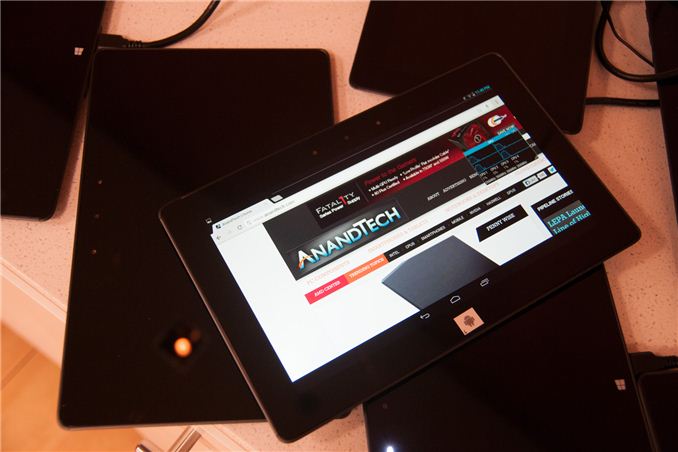
Earlier this year Intel unveiled Silvermont, its first true architectural update to Atom since its introduction in 2008. I won’t rehash Silvermont’s architecture here, but it’s designed to be a true test of Intel’s performance in the ultra mobile space. Leveraging Intel’s first 22nm SoC process and a very low power/efficient microarchitecture, Silvermont aims squarely at the latest Krait cores from Qualcomm and ARM’s Cortex A15.
Today Intel takes the next step forward, introducing the first tablet SoC based on Silvermont: Bay Trail.
Bay Trail takes up to four Silvermont cores, and for the first time in an ultra mobile Intel SoC pairs them with Intel’s own graphics IP. That’s right, rather than using a GPU block from Imagination Technologies, Bay Trail leverages the same GPU architecture as Ivy Bridge.
The first Bay Trail tablets will be shipping by the end of the year, across both Android and Windows 8.1. Intel expects Bay Trail to show up in tablets and 2-in-1s priced below $599, with everything above $599 falling under Haswell’s jurisdiction.
Bay Trail & Branding
Bay Trail, like all Atom platforms before it, will be available in multiple form factors. Unlike the Atoms of yesterday however, the SoC will carry Pentium and Celeron branding when used in notebooks and desktops. Intel didn’t disclose too much about its Silvermont plans in other form factors other than some basic naming:
Basically notebooks ship under the Pentium N3000 & Celeron N2000 series, while desktops will carry Pentium J2000 & Celeron J1000 branding. All Pentium SKUs seem to be quad-core, while Celeron SKUs will be available in both dual and quad-core versions.
Thankfully Intel shied away from introducing the same complexity with its tablet focused Bay Trail parts. All Bay Trail tablet SKUs carry Atom branding. There’s the quad-core Z3700 series and the dual-core Z3600 series.
Although Intel offers both dual and quad-core Bay Trail SKUs, they are both based on the same single physical design. In other words, dual-core Bay Trail parts are just die harvested quad-core parts. Intel isn’t disclosing die size or transistor counts, which is ironic (and disappointing) given that Apple just disclosed both (or at least relative magnitude of one) for its A7 SoC.
Internally, the Bay Trail design is pretty nice. There are either two or four cores enabled, each pair with a shared 1MB L2 cache (2MB total for a quad-core part). Intel is following the unfortunate lead of everyone else in the mobile industry and advertising max turbo frequencies exclusively.
Thankfully Intel hasn’t yet decided to obfuscate max non-turbo frequencies:
| Bay Trail Turbo Speeds | ||||||||
| Z3770 | Z3770D | Z3740 | Z3740D | Z3680 | Z3680D | |||
| Max turbo frequency | 2.39GHz | 2.41GHz | 1.86GHz | 1.83GHz | 2.0GHz | 2.0GHz | ||
| Max non-turbo Frequency | 1.46GHz | 1.5GHz | 1.33GHz | 1.33GHz | 1.33GHz | 1.33GHz | ||
In general you’re looking at 1.33GHz - 1.46GHz max non-turbo frequencies, with Bay Trail being able to turbo up to anywhere between 1.83GHz and 2.40GHz depending on SKU.
Although the core architecture is 64-bit in design, there will be no OS support for 64-bit Bay Trail at launch. Windows 8.1 with Connected Standby appears to still be 32-bit only, and obviously Android is 32-bit only at this point as well.
The memory interface is fairly ridiculous by mobile standards. You either get two 64-bit LPDDR3 channels (128-bit total width) or a single 64-bit DDR3L channel. In the case of the former, that’s the same memory bus width as Apple’s A5X/A6X line of SoCs as well as the standard Core i3/i5/i7 parts. Max supported memory frequency is 1066MHz in dual-channel LPDDR3 mode, or 1333MHz in single-channel DDR3L mode. The only benefit to the latter is really cost, as Bay Trail will purportedly show up in some very cheap devices.
The GPU is Intel’s own Gen7 graphics core, a cut down implementation of what we first saw in Ivy Bridge. I suppose it’s premature to expect Merrifield, Bay Trail’s smartphone counterpart, to also use Intel’s own graphics core but it’s clear this is the direction Intel is headed in - and away from licensing IP from Imagination Technologies.
Rather than 16 EUs in the Ivy Bridge GT2 configuration (HD 4000), Bay Trail’s HD Graphics core ships with 4. The 4 EUs are otherwise effectively identical to what we found in Ivy Bridge. The GPU can dynamically scale frequency and share power between itself and the CPU cores. Minimum GPU frequency on Bay Trail is 311MHz and a max GPU frequency of 667MHz (or 688MHz for the DDR3L SKUs).
Intel is quick to point out that Bay Trail’s GPU supports DirectX 11 and OpenGL ES 3.0. Unfortunately this support list appears limited to Windows. Under Android, it’s unclear whether or not Bay Trail will ship with anything above OpenGL ES 2.0 support. The same goes for GPU accelerated Renderscript. Bay Trail supports up to 2560 x 1440 displays over eDP1.3/DP1.2, or 1080p over HDMI. Panel Self Refresh is also supported.
Video encode and decode blocks also shifted away from Imagination in Bay Trail. Both IP blocks are custom from Intel now. The ISP (Image Signal Processor) is from Silicon Hive (an Intel acquisition).


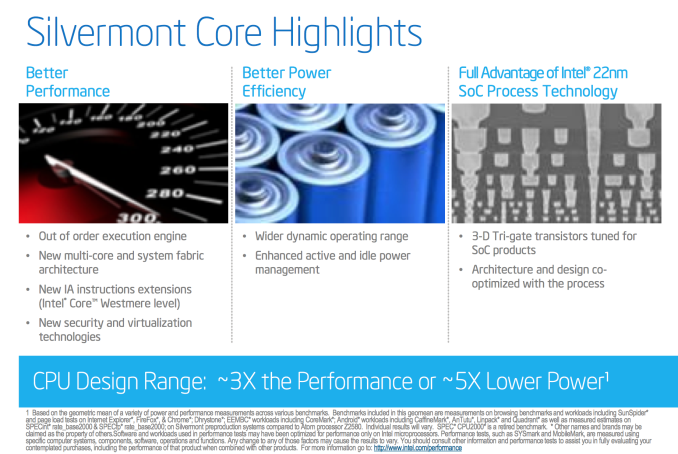
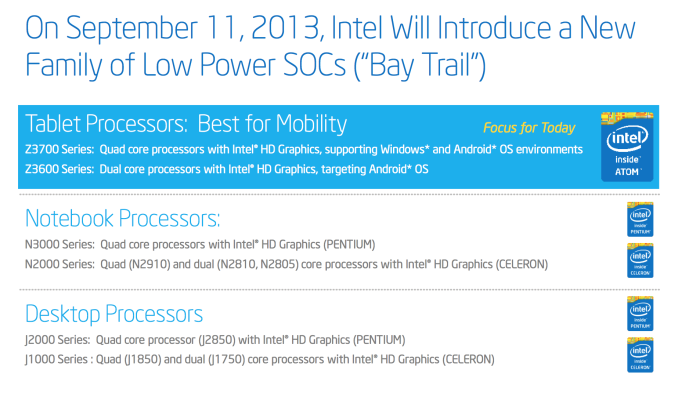
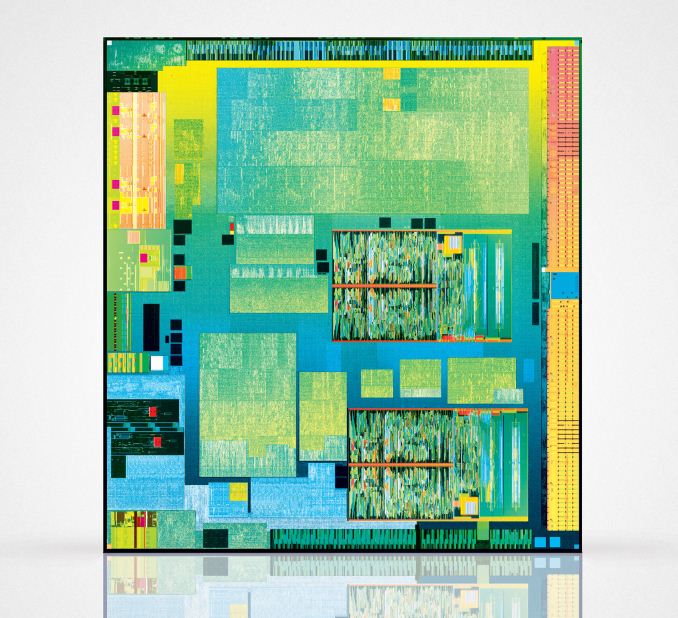
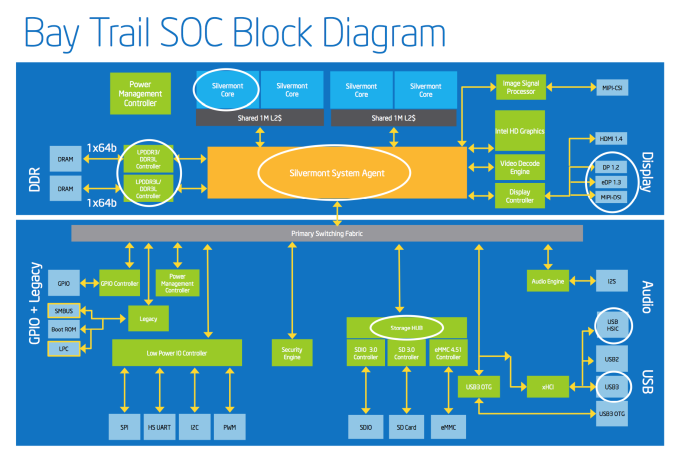
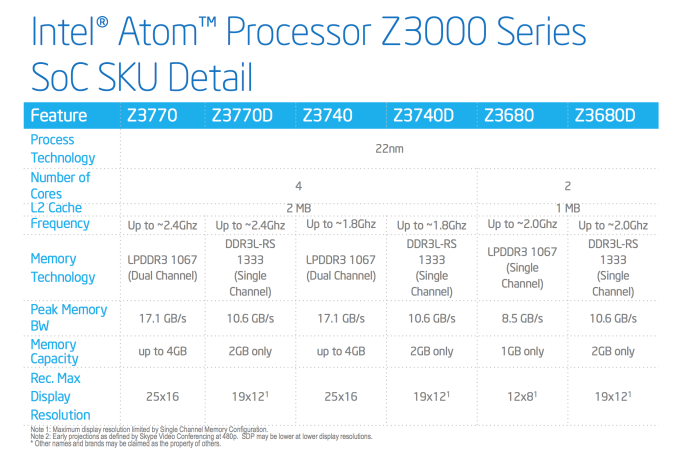
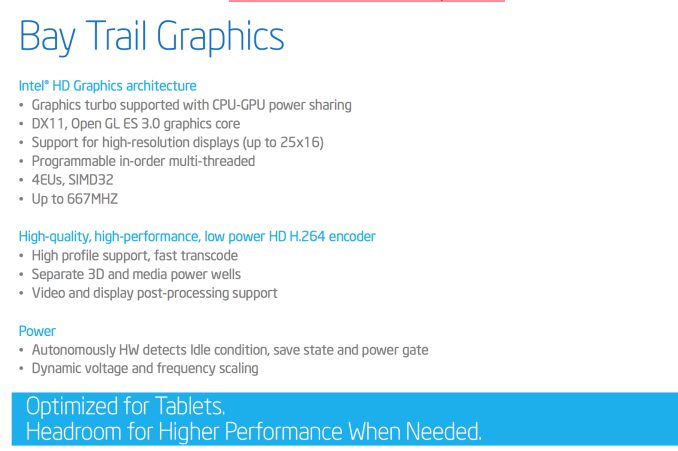
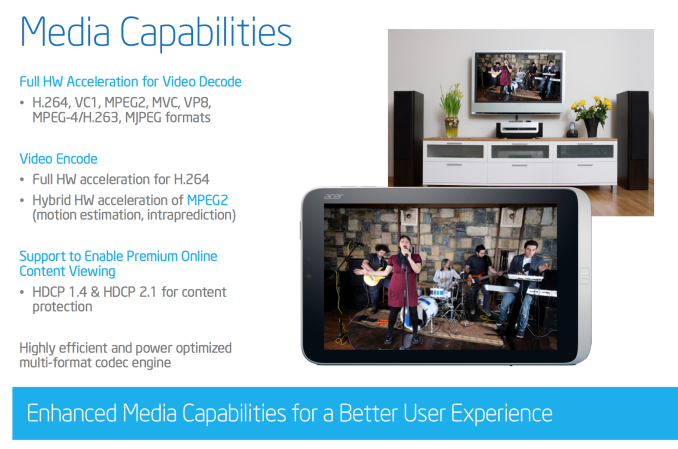








190 Comments
View All Comments
name99 - Wednesday, September 11, 2013 - link
Uhh, his point is COMPLETELY valid.The actually existing usage models of these devices is very much short sprints for which high throughput is ideal, followed by long bursts of doing nothing. Yes, this doesn't match a particular class of games, and doesn't match whatever weird inappropriate process (like cinebench) that you want to run on your phone, but it matches how MOST people uses their phones (and tablets).
This is the one area where, IMHO, Intel have a clear advantage over ARM. But I suspect it is very much a temporary advantage. Apple, for example, obviously spent all their A7 design time getting the 64-bit in place, and on the remaining low-lying micro-architectural fruit. But I expect that for the next chip, this sort of ability, to turbo up to high frequencies for short periods of time, will be their primary focus.
romanov123 - Wednesday, September 11, 2013 - link
Well, how about Skype/Google hangouts or watching a movie? Most turbo benefits will also show up in launching apps.And as you say Apple still needs to figure out Turbo while Intel has launched a product with it.
Valis - Wednesday, September 11, 2013 - link
No x64? Guess I wont be getting one of these, right now then. I'd rather run Ubuntu on it than Android, since the latter is better for smartphones. Ubuntu being based on my beloved Debian that I have been using since the stoneage of linux. =)blandge - Wednesday, September 11, 2013 - link
Bay Trail supports 64bit for Windows and Linux.Valis - Wednesday, September 11, 2013 - link
Quote:"Although the core architecture is 64-bit in design, there will be no OS support for 64-bit Bay Trail at launch. Windows 8.1 with Connected Standby appears to still be 32-bit only, and obviously Android is 32-bit only at this point as well."
So, it's just the drivers and such missing? Ohh, okej then. :)
lmcd - Wednesday, September 11, 2013 - link
Yeah it's just the power optimizations landed in 32-bit first (probably easier plus 32-bit is all that's needed for these LP devices)RU482 - Wednesday, September 11, 2013 - link
Yeah, they said CedarTrail was supposed to have 64-bit support to, but then pulled the rug at the last moment. These BayTrail-t CPUs are going to be so short lived, don't expect much from Intel support after about January (if that long). They dedicate the resources to Airmont-tzeo - Wednesday, September 11, 2013 - link
Cedar Trail technically did but because it used Imagination GPU the driver support never materialized, especially after Intel decided to give up on netbook range ATOM and re-purposed it for the mobile market. Even some of the D Series Cedar Trail models were terminated in the same year of release.Bay Trail, though is using Silvermont architecture that is fully 64bit and is using Intel's own GMA based on a scaled down version of the Ivy Bridge HD4000... and Linux support for Intel's driver support was added back in April btw!
The only thing is Intel isn't pushing the 64bit advantage for mobile devices but Bay Trail is also going into Laptops and desktops/servers... specifically the Bay Trail M and D series that'll be sold under the Celeron and Pentium Brand names will be when they push the 64bit advantage but since it's the same architecture it means you should be able to get drivers for all Silvermont based devices...
Freddo - Wednesday, September 11, 2013 - link
I look forward to the day when these energy efficient processors are powerful enough to properly run a PS2 emulator, but it seems like I have to wait a few more years still.Dentons - Wednesday, September 11, 2013 - link
Yes, it's better than ARM, but is it better enough?Clearly, the answer is no. For most tablets and phones, it's not nearly better enough.
Convincing existing ARM vendors to move to Intel will not be an easy task. There will be huge costs involved. In order to drive such a move, Intel would need far better performance or a far better price point, but probably both. It seems unlikely that Intel has either. The performance is only minimally better than ARM's current offerings, and while we don't know pricing, given that Intel has the highest margins in the industry and ARM among the lowest, one must assume that Intel's new silicon won't be price competitive with ARM.
So where will these chips shine? The only place they seem likely to find a home is in full (non-RT) X86 Windows 8 tablets and phones. Windows is the only large mobile player that requires X86. For the rest of the market, X86 is a liability.
Intel may mark this a success if it kills off Windows RT. In that singular goal, these chips seem likely to succeed. Such a victory will do little to make Intel powered tablets competitive with Android. Full X86 Windows boxes will have the full duo of WinTel taxes. Because of this, it's hard to see these products ever being price competitive with Android, not to mention the dearth of mobile apps on the Windows platform.
Intel and Microsoft have allowed ARM and Android too large of a head start. Now, their lead may be nearly insurmountable.